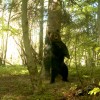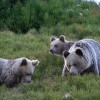Brown bear, although a charismatic and majestic species shared the dramatic fate of wolf, lynx and other large carnivores in most of the European countries. In the past, the main cause of brown bear mortality in Poland (or more generally in the Western Carpathians) was the intentional and official killing by people.

Since 1952, when the brown bear became a protected species, the cases of legal culling and trapping aiming to eliminate individual bears have been extremely rare in Poland. However, the main causes of bear mortality in Poland seems to be still of human origin. The cases of illegal killing or poaching are suspected to be still relatively common nowadays.
Recently, human disturbance is becoming an increasingly important cause of bear mortality. The increased access and disturbance of forest areas inhabited by bears due to forestry and hunting, antler gathering, tourism, recreation and sport, mainly winter sports, together with the shortage of areas free of disturbance where the animals could find refuge, is an important problem. Activities like picking forest fruits, especially bilberries, not only disturb bears, but also reduce their food resources. A relevant cause of cub mortality is den abandonment by the female due to human disturbance. In the last decades several such cases were recorded in Beskid Żywiecki and Bieszczady region. Den abandonment was mainly caused by gathering of red deer antlers, but also by forestry works and hunting. Traffic accidents are still of less importance in Poland, but an increase may be expected in the close future. Given the limited numbers of brown bears in Poland, each mortality event most probably represents a significant loss for the population.
The brown bear population in Poland is transboundary and, thus, it status depends to a great extent on the brown bear management in Slovakia. The goals of the protection and regulatory bear culling in Slovakia are the elimination of problem bears and the control of the bear population, respectively. In the last years (2000-2009), in Slovakia 277 bears were harvested under the regulatory culling and 44 under the protection culling. Culling represents 70% of the bear mortality in Slovakia. Evidence shows that it may affect bears living in the Polish territory and therefore, also the conservation status of the population in Poland. We propose a close cooperation between Slovakia and Poland in this issue to commonly design the border areas where bear culling should not be allowed, with special attention to the potential reconnection of the western and eastern segments of the population.
The damages caused by brown bears in Poland are not very numerous, and significantly lower than those produced by other protected species. Whereas the number of bear damages is low and stable in Śląskie and Małopolskie Voivodships (compensation costs of about few thousand PLN), in the Podkarpackie Voivodship the number of damages has been increasing in the last decade and damage compensations reached 250,000 PLN in 2010. Most bear damages concern apiaries.
 Cases of habituation and food conditioning of brown bears are known from all over their wide range, both in areas where bears are subject to strict protection and where the species is hunted. In Poland, this phenomenon is best known in Tatra Mountains, where habituated and more often food conditioned bears appear almost every year since the 80s. The appearance of problem bears in Tatra was mainly due intentional feeding. The magnitude of this problem has been significantly reduced since proper waste management, deterrence and aversive conditioning of bears have been implemented systematically during the last decade of last century.
Cases of habituation and food conditioning of brown bears are known from all over their wide range, both in areas where bears are subject to strict protection and where the species is hunted. In Poland, this phenomenon is best known in Tatra Mountains, where habituated and more often food conditioned bears appear almost every year since the 80s. The appearance of problem bears in Tatra was mainly due intentional feeding. The magnitude of this problem has been significantly reduced since proper waste management, deterrence and aversive conditioning of bears have been implemented systematically during the last decade of last century.
During recent years, it has been observed an important increase of this phenomenon in the Bieszczady region. Most bears in Bieszczady are strongly conditioned by supplemental food provided for game (representing 1/3 of the bear diet), and their movements seems also to be influenced by the location of the feeding sites. These bears can easily become problem individuals, or even nuisance bears. Intentional luring and feeding of bears, also with wastes of human food and leftovers from slaughterhouses, aiming to create a local tourist attraction, or to help in photo and video recording, is becoming more and more popular in Bieszczady. This activity is beyond any control. At the same time, considering the lack of proper waste management from both local residents and tourists, it is clear that in the short term there may be drastic consequences and problem bears may appear quite soon in Bieszczady, unless measures are taken immediately.
Photo by Tomasz Zwijacz-Kozica and Carpathian Brown Bear Project





















